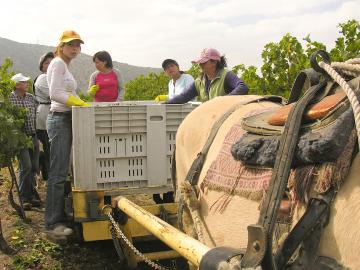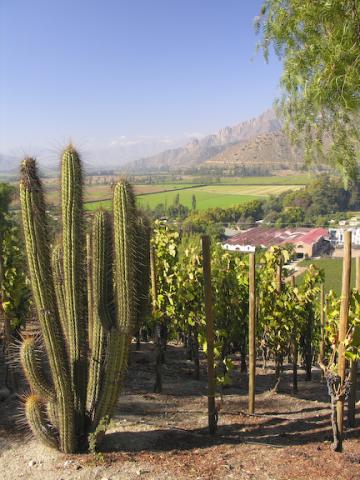Chilean Reds Prepare to Move Up
POSTED ON 27/10/1989“WE have a long history of wine in Chile,” said a journalist to Nicolas Belfrage, a visiting master of wine in March, “but no wine culture.” The analysis may seem a little harsh, but it took 300 years from the introduction of the grapevine to Chile by Spanish missionaries for the industry to take root.
Until the pioneering vine-grower Silvestre Ochagavia imported quality European varieties into Chile in 1851, the popular staples were the pais, similar to the mission vine of California, and the muscatel, much favoured as a base for the mood-enhancing eau-de-vie, Pisco. Ochagavia planted the Bordeaux varieties, cabernet sauvignon, merlot, malbec, sauvignon and semillon, along with Germany’s riesling on his estate south of Santiago in Chile’s Central Valley. Extending from the Aconcagua River Valley north of Santiago down to the cool Maule River Valley, the Central Valley region, at an altitude of between 1,200 and 2,200 feet, is second in vineyard surface (91,800 acres) to the South Central Secano region (112,000 acres), but more important.
 Chile's harvest
Chile's harvest
Uniquely, Chile has not had to cope with the problem of grafting its vines on to phylloxera-resistant American rootstock. The phylloxera pest that sucked the lifeblood form the world’s vineyards in the latter half of the nineteenth century has failed to affect Chile’s vineyards. Whether this is thanks to natural geographic barriers – Pacific to the west, Andes to the east, Atacama desert above, Antarctica below – or because the pest can’t swim in Chile’s irrigated vineyards, is uncertain.
Do phylloxera-free vines contribute directly to quality? As they are relatively free from disease and super-efficient at handling sap flow, the answer seems to be yes. The cold Humboldt current and cool air sliding off the Andean ice-caps into the valleys at night combine with dry, sunny days to create another bonus for quality wine production – ideal heat, light and extremes of temperature. With the snow-capped Andes providing a dramatic backdrop to the vineyards, Chile, according to the Spanish winemaker Miguel Torres, “is a viticultural paradise”.
Not counting a certain Drake’s piratical seizure of a galleon carrying 1770 wineskins from Chile to Peru in 1578, Chile exported wine to Europe for the first time in 1877. Production rose gradually to 275 million litres by 1903, but a host of subsequent problems – Prohibition in the USA, a ban on planting between 1938 and 1974, severe marketing restrictions and an anti-alcohol drive in Chile itself – all contributed to the decline of the wine industry. After a boom in the Seventies, production has fallen from 600 million litres to 350 million, little more than the 1903 figure, as farmers have found that there is more money in selling fruit than wine.
 Errazuriz, Aconcagua
Errazuriz, Aconcagua
Consumption, too, has plummeted from an estimated 70 litres per head in 1930 to just under half that figure today. This downturn has put pressure on exports, which halved in the early Eighties. Britain, which imported a mere 6,700 cases of Chilean wine in 1983, last year imported more than 10 times that amount. Small wonder the Chileans welcome our Master of Wine delegation with open arms and order books. Chile needs sterling. But has it got what it takes to justify British investment?
To try to answer that, we decided to taste a representative sample of Chilean wines available in Britain, inviting shippers to send us a sample of a red and a white wine.
We were joined on the panel this month by two Masters of Wine who went on the trip to South America – Lorne Mackillop and Maggie McNee – and one who didn’t, Jane Hunt; also Michael Edwards, wine editor of the Egon Ronay Guide; Andrew Henderson, chairman of the Chilean Wine Importers Committee; Barry Ralph, of the Upper Crust, East Horsley, WINE magazine Wine Merchant of the Year; Rainer Lingenfelder, one of Germay’s most innovative young wine-makers; and Tony Keys, wine consultant. Wines were tasted blind, as usual, with marks based purely on quality rather than price.
A clear preference emerged for the reds, which were purer, lighter and softer in style than many of us had expected. The varietal character of the cabernet sauvignon in particular, was impressive if a little simple in its unblended, 100 per cent cabernet sauvignon form.
ON a critical note, Lorne Mackillop echoed a common view that some wines suffered from “too long exposure to old oak which adds drying tannins and kills the fruit”. Most of us also felt that, attractive as the reds were on the whole, they lacked that extra complexity that distinguishes a great wine from a good one.
The white wines were less consistent, with too many losing fruit because of old-style winemaking or over-enthusiastic use of sulphur dioxide. Only the excellent Canepa Estate Vino Blanco offered hope of excitement to come from Chile’s whites.
With all 26 wines tasted available for under a fiver, however, and one or two for quite a bit less, we unanimously agreed with Michael Edwards when he summed up: “The wines overall offer good value for money with price, rather than any strong character or dramatic quality, their best card.”
If Chile can maintain the quality-price ratio, improve its whites and not relapse into political instability, it could fill the vacuum left by Rioja’s declining fortunes in Britain.

